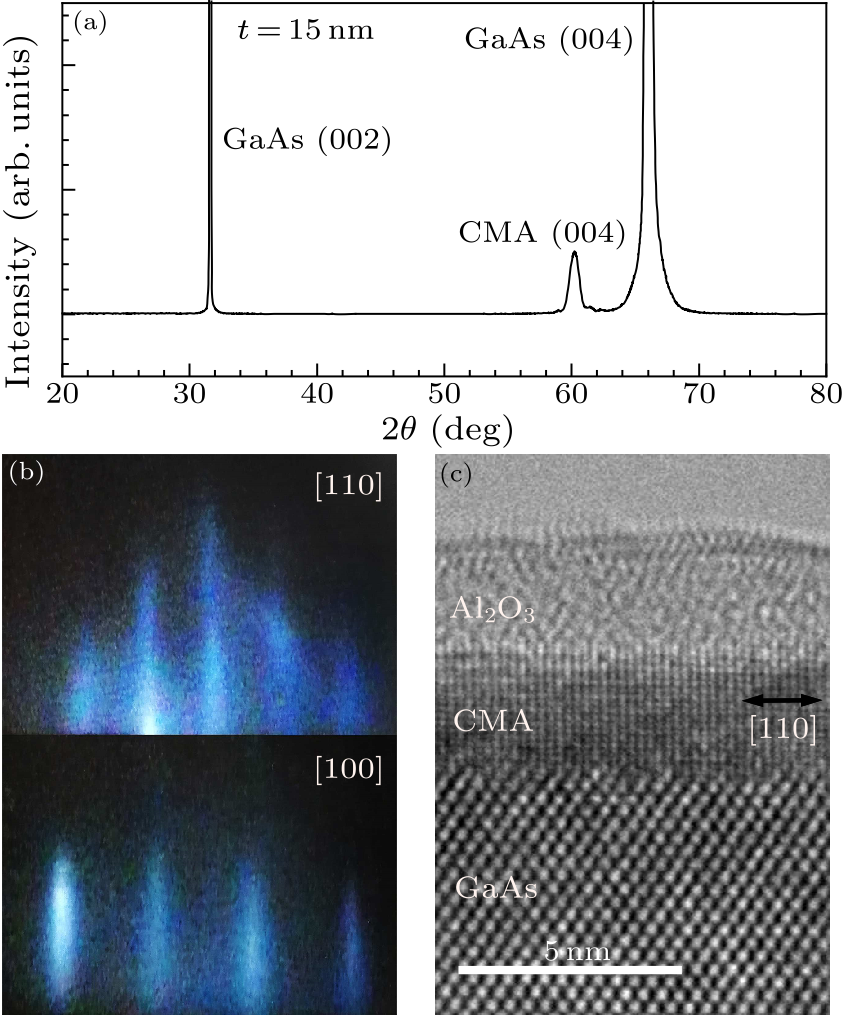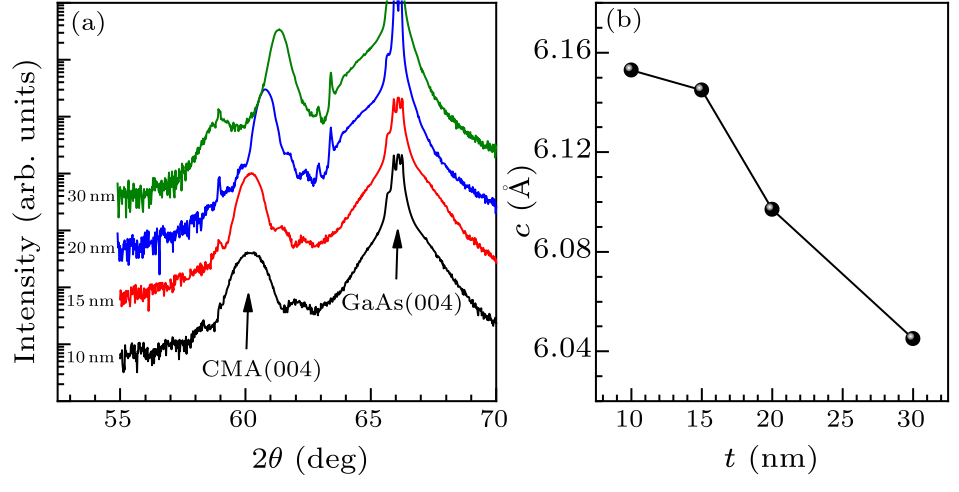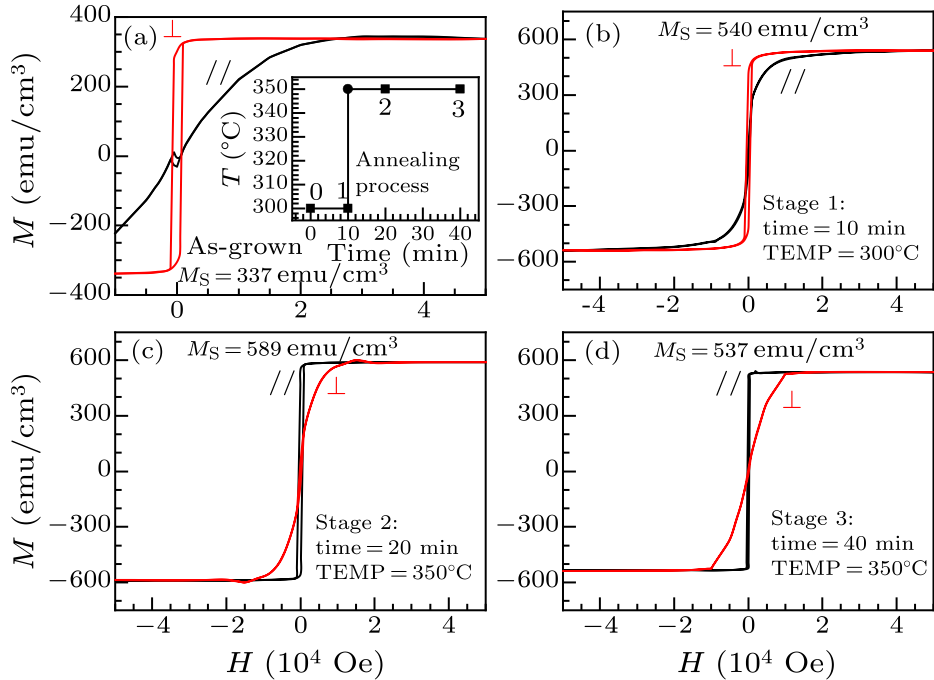
Fig. 1. (a) XRD $\theta$–$2\theta$ scans for a 15-nm-thick CMA film on a GaAs (001) substrate. (b) CMA RHEED patterns with electrons parallel to the [100] and [110] azimuths. (c) The TEM image of a 2.5-nm-thick CMA film.

Fig. 2. (a) XRD $\theta$–$2\theta$ scans for CMA films, with $t$ increasing from 2.5 nm to 30 nm. (b) The relation of $c$ versus $t$.
| $t$ | $c/a_{\rm GaAs}$ | $M_{\rm S}$ | $H_{\rm C}$ | $M_{\rm R}/M_{\rm S}$ | $K_{\rm u}$ |
|---|---|---|---|---|---|
| (nm) | (emu/cm$^{3})$ | (Oe) | (Merg/cm$^{3}$) | ||
| 2.5 | 373 | $ < 100$ | 0.995 | 1.06 | |
| 10 | 1.089 | 337 | 730 | 0.895 | 3.41 |
| 15 | 1.088 | 353 | 1700 | 0.895 | 2.72 |
| 20 | 1.079 | 270 | 770 | 0.964 | 2.52 |
| 30 | 1.070 | 280 | 1830 | 0.265 | 1.88 |

Fig. 3. (a)–(e) Hysteresis loops of CMA films with different $t$ values. (f) The change of coercivity ($H_{\rm C}$), saturation magnetization ($M_{\rm S}$), loop squareness ($M_{\rm R}/M_{\rm S}$) and PMA energy ($K_{\rm u}$) versus $t$.

Fig. 4. (a) The hysteresis loop of the as-grown 10 nm sample. The inset shows the annealing process on the same 10-nm-thick film. (b)–(d) The hysteresis loops of the films at different annealing stages corresponding to the point in the inset of (a).
| [1] | de Groot R A, Mueller F M, van Engen P G and Buschow K H J 1983 Phys. Rev. Lett. 50 2024 | New Class of Materials: Half-Metallic Ferromagnets
| [2] | Trudel S, Gaier O, Hamrle J and Hillebrands B 2010 J. Phys. D 43 193001 | Magnetic anisotropy, exchange and damping in cobalt-based full-Heusler compounds: an experimental review
| [3] | Picozzi S, Continenza A and Freeman A J 2002 Phys. Rev. B 66 094421 | Ge, Sn) Heusler compounds: An ab initio study of their structural, electronic, and magnetic properties at zero and elevated pressure
| [4] | Graf T, Felser C and Parkin S S P 2011 Prog. Solid State Chem. 39 1 | Simple rules for the understanding of Heusler compounds
| [5] | Kent A D 2010 Nat. Mater. 9 699 | Perpendicular all the way
| [6] | Liu H F, Ali S S and Han X F 2014 Chin. Phys. B 23 077501 | Perpendicular magnetic tunnel junction and its application in magnetic random access memory
| [7] | Zeng Z, Amiri P K, Krivorotov I N, Zhao H, Finocchio G, Wang J P, Jordan A K, Huai Y M, Langer J, Galatsis K, Wang K L and Jiang H W 2012 ACS Nano 6 6115 | High-Power Coherent Microwave Emission from Magnetic Tunnel Junction Nano-oscillators with Perpendicular Anisotropy
| [8] | Hirohata A, Frost W, Samiepour M and Kim J Y 2018 Materials 11 105 | Spin-polarized tunneling
| [9] | Mao S W, Lu J, Zhao X P, Wang X L, Wei D H, Liu J, Xia J B and Zhao J H 2017 Sci. Rep. 7 43064 | MnGa-based fully perpendicular magnetic tunnel junctions with ultrathin Co2MnSi interlayers
| [10] | Hiratsuka T, Kim G, Sakuraba Y, Kubota T, Kodama K, Inami N, Naganuma H, Oogane M, Nakamura T, Takanashi K and Ando Y 2010 J. Appl. Phys. 107 09C714 | Fabrication of perpendicularly magnetized magnetic tunnel junctions with L10-CoPt/Co2MnSi hybrid electrode
| [11] | Wen Z, Sukegawa H, Kasai S, Hayashi M, Mitani S and Inomata K 2012 Appl. Phys. Express 5 063003 | Magnetic Tunnel Junctions with Perpendicular Anisotropy Using a Co$_{2}$FeAl Full-Heusler Alloy
| [12] | Jamer M E, Assaf B A, Devakul T and Heiman D 2013 Appl. Phys. Lett. 103 142403 | Magnetic and transport properties of Mn 2 CoAl oriented films
| [13] | Feng Y, Zhou T, Chen X, Yuan H and Chen H 2015 J. Magn. Magn. Mater. 387 118 | The effect of Mn content on magnetism and half-metallicity of off-stoichiometric Co 2 MnAl
| [14] | Meng K K, Miao J, Xu X G, Zhao J H and Jiang Y 2017 Phys. Lett. A 381 1202 | Thickness dependence of magnetic anisotropy and intrinsic anomalous Hall effect in epitaxial Co2MnAl film
| [15] | Xiao J X, Lu J, Zhu L J and Zhao J H 2016 Acta Phys. Sin. 65 118105 (in Chinese) | Perpendicular magnetic properties of ultrathin L10-Mn1.67Ga films grown by molecular-beam epitaxy
| [16] | Zhu L J, Nie S H, Meng K K, Pan D, Zhao J H and Zheng H 2012 Adv. Mater. 24 4547 | Multifunctional L10-Mn1.5Ga Films with Ultrahigh Coercivity, Giant Perpendicular Magnetocrystalline Anisotropy and Large Magnetic Energy Product
| [17] | Yakushiji K, Saruya T, Kubota H, Fukushima A, Nagahama T, Yuasa S and Ando K 2010 Appl. Phys. Lett. 97 232508 | Ultrathin Co/Pt and Co/Pd superlattice films for MgO-based perpendicular magnetic tunnel junctions
| [18] | Yoshikawa M, Kitagawa E, Nagase T, Daibou T, Nagamine M, Nishiyama K, Kishi T and Yoda H 2008 IEEE Trans. Magn. 44 2573 | Tunnel Magnetoresistance Over 100% in MgO-Based Magnetic Tunnel Junction Films With Perpendicular Magnetic L1$_{0}$-FePt Electrodes
| [19] | Winkelmann A, Przybylski M, Luo F, Shi Y and Barthel J 2006 Phys. Rev. Lett. 96 257205 | Perpendicular Magnetic Anisotropy Induced by Tetragonal Distortion of FeCo Alloy Films Grown on Pd(001)
| [20] | Ouardi S, Kubota T, Fecher G H, Stinshoff R, Mizukami S, Miyazaki T, Ikenaga E and Felser C 2012 Appl. Phys. Lett. 101 242406 | Stoichiometry dependent phase transition in Mn-Co-Ga-based thin films: From cubic in-plane, soft magnetized to tetragonal perpendicular, hard magnetized
| [21] | Ikeda S, Miura K, Yamamoto H, Mizunuma K, Gan H D, Endo M, Kanai S, Hayakawa J, Matsukura F and Ohno H 2010 Nat. Mater. 9 721 | A perpendicular-anisotropy CoFeB–MgO magnetic tunnel junction
| [22] | Wu D, Liu G L, Jing C, Wu Y Z, Loison D, Dong G S, Jin X F and Wang D S 2001 Phys. Rev. B 63 214403 | Magnetic structure of alloys
| [23] | Hilton J L, Schultz B D, McKernan S and Palmstrøm C J 2004 Appl. Phys. Lett. 84 3145 | Interfacial reactions of Mn/GaAs thin films